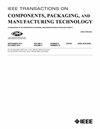微电子器件静电力微循环冷却系统的设计与实现
IF 3
3区 工程技术
Q2 ENGINEERING, ELECTRICAL & ELECTRONIC
IEEE Transactions on Components, Packaging and Manufacturing Technology
Pub Date : 2025-03-26
DOI:10.1109/TCPMT.2025.3554926
引用次数: 0
摘要
本研究描述了一种用于微电子元件的散热器的设计。建议的技术依赖于利用电极上的电偏压产生静电力,这对散热器内的冷却剂起作用。散热器的冷却剂涡流是通过结构设计和电极间的电位差相结合产生的,位于散热器顶部的电子设备可以进行冷却和传热。这一思想是有限元仿真的基础,该仿真模拟了静电力作用下散热器内冷却剂的流动和换热,并研究了其他因素(如通道直径和间距)的影响。此外,散热器采用3d打印技术制造。利用充放电对散热器进行了检查,并展示了对散热器的冷却剂流动进行管理的基本实现。该设备通过电压控制散热器冷却剂的速率,具有低能耗和轻便紧凑的形式。本文章由计算机程序翻译,如有差异,请以英文原文为准。
Design and Implementation of an Electrostatic Force-Based Microcirculation Cooling System for Microelectronic Devices
This study describes the design of a radiator for use in microelectronic components. The suggested technology depends on generating electrostatic force by using the electric bias on the electrodes, which takes effect on the coolant within the radiator. The coolant vortex of the radiator is created by combining the structural design and the potential difference across the electrodes, and the electronic devices positioned at the top of the radiator can perform cooling and heat transfer. This idea is the foundation for the finite element simulation, which simulates the coolant flow and heat transfer in the radiator under electrostatic force, and the influence of other factors, such as channel diameter and spacing, is also investigated. Furthermore, the radiator is manufactured using the 3-D printing technique. The radiator is examined using charge and discharge, and a rudimentary implementation of the role of managing the coolant flow of the radiator is exhibited. The equipment controls the rate of radiator coolant by voltage and has low energy consumption as well as a handy and compact form.
求助全文
通过发布文献求助,成功后即可免费获取论文全文。
去求助
来源期刊

IEEE Transactions on Components, Packaging and Manufacturing Technology
ENGINEERING, MANUFACTURING-ENGINEERING, ELECTRICAL & ELECTRONIC
CiteScore
4.70
自引率
13.60%
发文量
203
审稿时长
3 months
期刊介绍:
IEEE Transactions on Components, Packaging, and Manufacturing Technology publishes research and application articles on modeling, design, building blocks, technical infrastructure, and analysis underpinning electronic, photonic and MEMS packaging, in addition to new developments in passive components, electrical contacts and connectors, thermal management, and device reliability; as well as the manufacture of electronics parts and assemblies, with broad coverage of design, factory modeling, assembly methods, quality, product robustness, and design-for-environment.
 求助内容:
求助内容: 应助结果提醒方式:
应助结果提醒方式:


